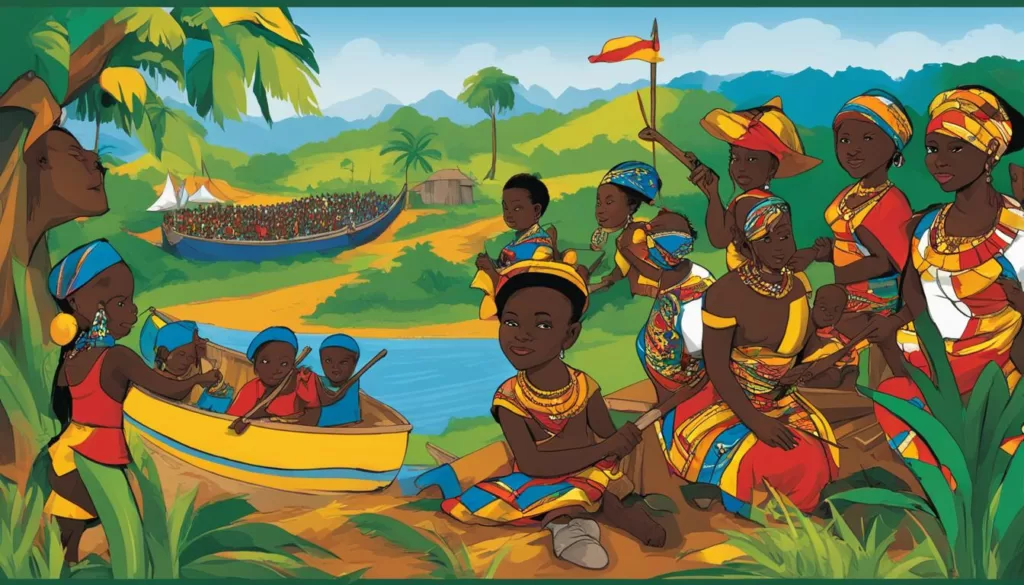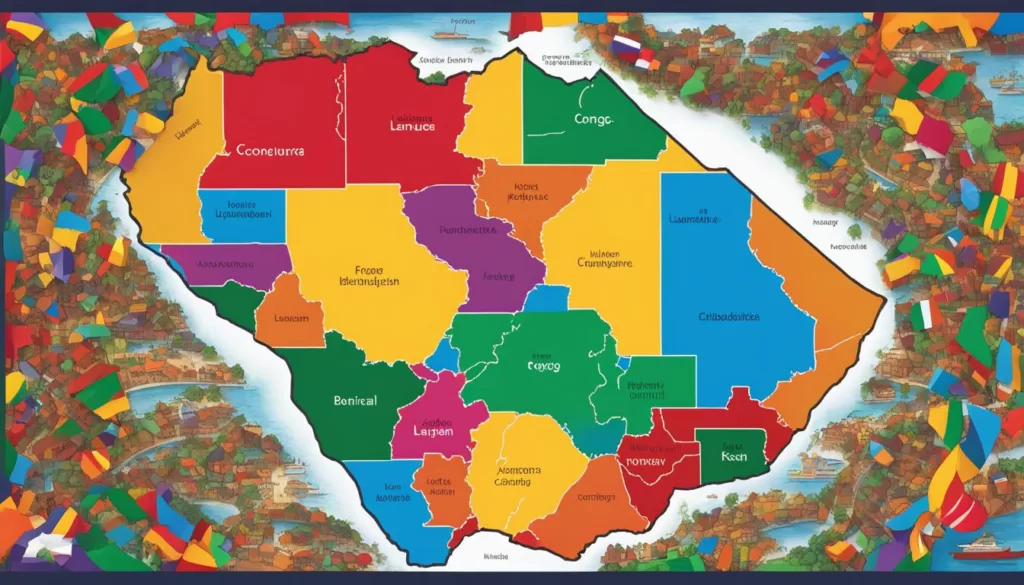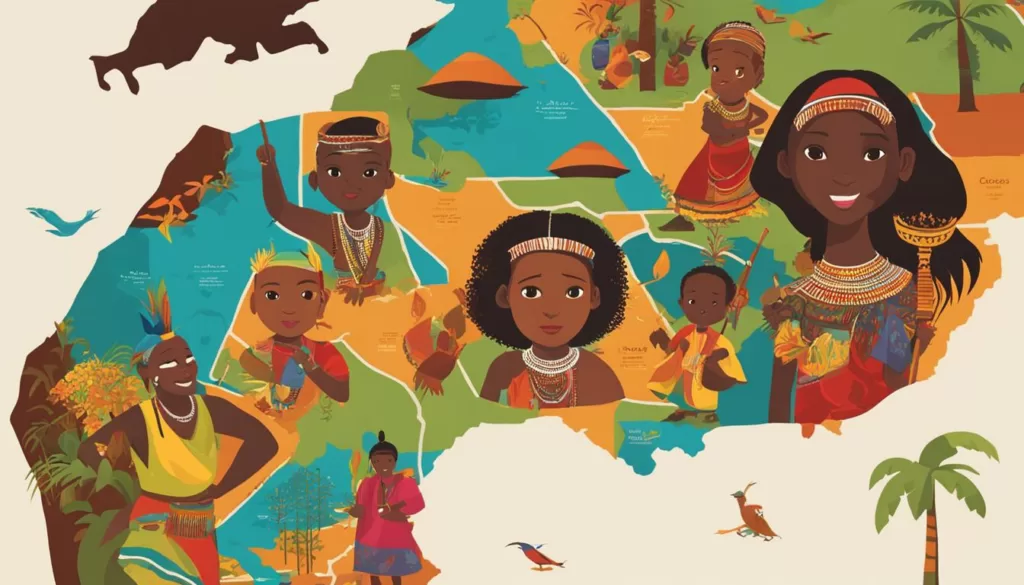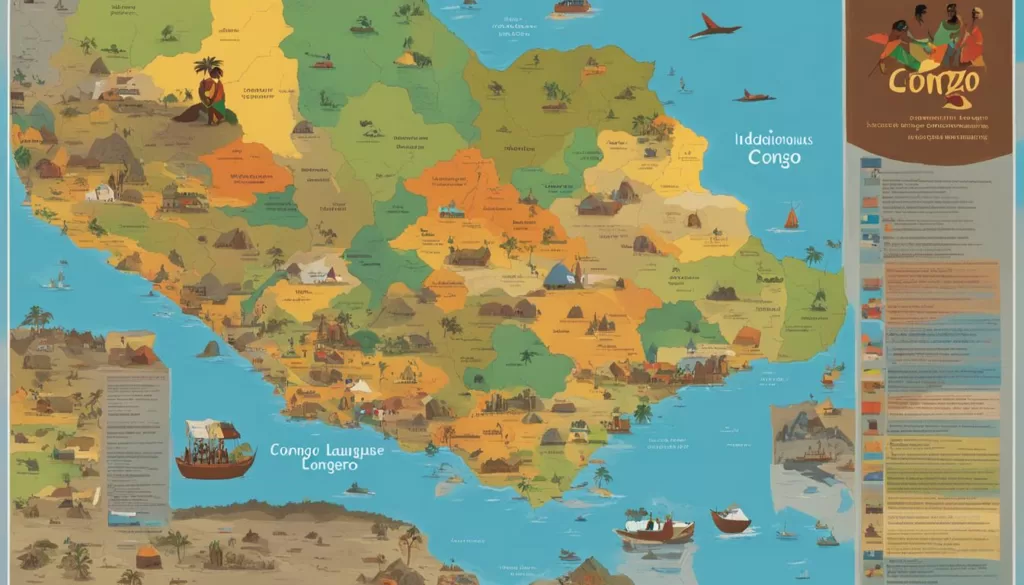The Democratic Republic of the Congo (DRC) stands as a tapestry of linguistic diversity, where voices in hundreds of languages rise in a symphony that narrates the country’s rich heritage. Nestled within the heart of Africa, the languages spoken in Congo act as a bridge connecting its vibrant communities. The official language of Congo is French, imparting a legacy of colonial history, yet fluently spoken by millions today. This European tongue coexists with four nationally recognized African languages—Kituba, Lingala, Swahili, and Tshiluba—each playing a vital role in the cultural and social dynamics of the nation. From urban centers to remote villages, these languages thrive, nurturing the identities of the Congolese across the vast landscape.
Key Takeaways
- French serves as the official language of Congo, a vestige of its colonial past, and a contemporary means of unity.
- There are four major African languages Congo has officially recognized, which include Kituba, Lingala, Swahili, and Tshiluba.
- Linguistic diversity is a cornerstone of Congolese society, with over 200 indigenous languages spoken across the country.
- Inclusion and practice of sign languages, such as American Sign Language, highlight the inclusivity of the Congolese language ecosystem.
- The intricate balance of languages in Congo underscores its rich cultural tapestry and complex historical narratives.
- As a lingua franca, the blend of French with indigenous languages facilitates cross-ethnic dialogue and cultural exchange.
The Linguistic Landscape of Congo
Traversing the Democratic Republic of Congo is akin to embarking on a linguistic odyssey. Here, an interwoven network of languages punctuates the air, each thread a testament to the country’s multifaceted cultural fabric. French, the official language, stitches this diverse tapestry together, providing a shared medium for interaction across the country’s manifold ethnic groups.

The Significance of French as the Official Language
In the heart of Africa’s linguistic mosaic, French stands as the Congo official language, uniting disparate cultures under one linguistic umbrella. Wielded by more than half of the population as a lingua franca, French does more than facilitate communication—it enriches governance, education, and even international relations, solidifying the Congo’s place in the Francophone world.
Dominance and Role of Regional and National Languages
Despite the prevalence of French, Congo’s heartbeat is expressed through its four national languages: Kituba, Lingala, Swahili, and Tshiluba. These Congo official languages are not merely modes of communication but are channels that carry the legacy of tradition and modernity within their cadence. They resonate within local governance, education systems, media broadcasts, and the everyday dialogue of millions, holding sway in their respective regions.
| Language | Region | Function |
|---|---|---|
| Kituba | Southwestern provinces | Cultural expression, trade, administration |
| Lingala | Northern Congo | Army communication, urban vernacular |
| Swahili | Eastern provinces | Regional trade, cross-border commerce |
| Tshiluba | Kasai regions | Local governance, education |
Indigenous and Minority Languages in Congo
Our exploration extends beyond the dominion of official and national idioms to the native languages Congo safeguards as part of its heritage. Over 200 tongues weave through the country’s social fabric, each with a unique timbre reflecting the diversity of Bantu, Ubangian, and Nilotic lineages found within. These indigenous and minority languages do not simply mark geographical territories; they are capsules of history, identity, and a resolute spirit that reverberates through the Congo’s land.
- Bantu languages fostering traditional narratives.
- Ubangian dialects echoing through northern forestry.
- Nilotic speech patterns tracing the footsteps of ancient cattle herders.
The voices of the Congo are as vast as the river that shares its name, each current a story, each ripple a song. Here, the soundscape is rich and ever-evolving—a reflection of the Congo’s enduring legacy as a cradle of linguistic wealth.
Congo’s Multilingualism: Beyond the Official Language
The Democratic Republic of Congo stands as a linguistic jewel in the heart of Africa, a place where the interplay of languages illustrates a society rich in cultural diversity. Deep within the Congolese social fabric, you’ll find a powerhouse of communication brought forth by the four national languages of Congo, alongside French, the official language. Kituba, Lingala, Swahili, and Tshiluba are not only tongues of respective regions but also serve as bridges between cultures, acting as significant lingua francas within Congolese society.

Exploring the Four National Languages of Congo
Each of the national languages Congo cherishes contributes uniquely to its multilingual identity. Kituba, or Kikongo ya leta, originates from a creole based on Kikongo and has evolved into a dominant vernacular language for trade and communication, particularly in the nation’s southwestern urban centers. Conversely, Lingala’s roots trace back to the upper Congo river area and it has secured its position as a guiding voice for the military and as an urban language in the North.
Swahili’s influence stretches from the shores of the East African coast into Congo’s eastern provinces, where it dons the name Kingwana and facilitates regional and cross-border business endeavors. Lastly, Tshiluba, with its dialects Luba-Kasai and Luba-Lulua, envelops the Kasai regions in its linguistic embrace, integral to both governance and education. These languages, preserved and promoted, encapsulate distinct cultural narratives that paint an authentic picture of the national identity.
The Function of Lingua Franca in Congolese Society
Substantial in its role, the concept of lingua franca Congo is exemplified by the collective use of these national languages. They stand as pillars of unity in a country with a complex ethnic mosaic, enabling communication and facilitating a cohesive society. The integrated use of these languages in media broadcasts, governmental functions, and day-to-day discourse allows for a sense of national identity, thus fostering social harmony and cultural exchange. As lingua francas, they confirm the Congo’s dedication to inclusivity and empowerment through language.
| Language | Region | Prevalence | Usage |
|---|---|---|---|
| Kituba (Kikongo ya leta) | Southwestern urban centers | Widely spoken | Trade, communication, administration |
| Lingala | Northern Congo, urban areas | Official language of the army, commonly spoken | Military communication, urban vernacular |
| Swahili (Kingwana) | Eastern provinces | Common in regional trade and media | Commerce, cross-border trade |
| Tshiluba | Kasai regions | Spoken across varied communities | Educational system, local governance |
Languages Spoken Congo: A Closer Look
The intricate tapestry of common languages Congo is not merely defined by its four major national languages but is enriched by an array of indigenous languages Congo that are integral to the nation’s cultural diversity. Each tongue carries with it the essence of the Congo’s various ethnicities, making every phrase, every word, a testament to the nation’s multifarious heritage. It’s not just the official language of French or national languages of Kituba, Lingala, Swahili, and Tshiluba that resonate within the Congolese communities. Instead, it is the breadth of regional dialects that truly showcase the nation’s unique linguistic panorama.

Historical influences have shaped the present linguistic landscape of Congo, with the spreading of Kikongo by Catholic missionaries and the Belgian colonization cementing French as the primary medium of education. The colonial past also saw the use of Dutch, which has since seen a decline in favor. Fast-forwarding to contemporary times, English, among other foreign languages, is increasingly finding its spot within the Congo’s business and diplomatic spheres.
The dynamic nature of the Congo’s linguistic fabric is perhaps best understood through the lens of education and media. School curricula and television programming, for instance, are as varied as the languages themselves, reflecting an inclusive approach to representing multiple ethnic voices. Moreover, the use of language in administrative and official capacities speaks volumes about the choice of communication rooted in practicality and inclusivity.
“The function of language is not merely to facilitate communication, but to construct realities, build societies, and shape identities.”
Below is an overview of the spread and utility of common and indigenous languages Congo citizens rely upon:
| Language | Ethnolinguistic Group | Typical Usage |
|---|---|---|
| Kikongo | Bakongo | Local governance, traditional ceremonies |
| Tshiluba | Baluba | Education, local media |
| Swahili | Swahili-speaking communities | Regional trade, cross-border relations |
| Lingala | Lingala-speaking communities | Armed forces, popular music |
| Mongo | Mongo people | Rituals, inter-tribal trade |
| Luba | Luba people | Cultural heritage preservation, education |
Traversing this linguistic realm, from the bustling streets of Kinshasa to the hills and valleys stretching far beyond the capital, the voices of Congo speak in a harmonious blend of tradition and modernity. It is this very diversity which encapsulates the core of the Congolese spirit—a spirit that echoes through the corridors of schoolhouses, the hushed whispers of prayer, and the loud clamors of urban marketplaces. The language preference for any given occasion depends much on the region, the audience, and the context—as it is through language that the Congolese connect with their past, engage with their present, and build towards a future replete with vibrant multicultural exchange.
Understanding Congo’s Dialects and Indigenous Languages
The Democratic Republic of the Congo’s linguistic heritage showcases a stunning palette of dialects and linguistic forms, with each one carrying the enduring imprint of indigenous and local origins. Delving into the various indigenous languages Congo harbors is more than an academic exercise; it is a journey into the heart of myriad societies, each speaking their truth in their own linguistic sounds and scripts.

Much like the threads of a vibrant fabric, these languages intertwine to form the complex cultural mosaic that is the Congo. As we parse through the richness of African languages Congo boasts, we quickly discern the crucial role language plays in preserving the unique cultures that sprawl across its vast lands.
Preserving Indigenous Cultures Through Language
The continual existence of Congo’s indigenous cultures is inextricably bound to the enduring voices of their languages. From the widely spoken Mongo and Luba languages that function as the cornerstones of their respective communities, to less common tongues like Kifuliiru and Komo, each language serves as both a preserver and a transmitter of culture, identity, and history.
| Language | Community | Usage |
|---|---|---|
| Mongo | Mongo people | Community traditions, rituals |
| Luba | Luba-Kasai and Luba-Lulua groups | Cultural ceremonies, education |
| Kifuliiru | Peoples of Uvira territory | Oral history, social gatherings |
| Komo | Komo communities | Spiritual practices, kinship communication |
As the world becomes increasingly interconnected, the preservation of these languages is not just a cultural imperative but also a critical factor in sustaining the biodiversity of global knowledge and perspectives housed within the Congo’s borders.
Kikongo ya Leta and Other Creoles: Lingual Hybrids
Beyond the wealth of traditional tongue, the Congolese linguistic environment is also characterized by creole languages like Kikongo ya Leta, commonly known as Kituba. Emerging from a melding of indigenous Kikongo with colonial influences, these Creoles stand as tangible artifacts of historical contact, adaptation, and cultural hybridity.
- Kituba: Enabling widespread understanding and interaction along the heavily trafficked Congo-Océan railway corridor and beyond.
- Lingala: Originated as a trade language along the Congo river, now a vibrant urban vernacular and the voice of Congolese music.
These creole languages perform a pivotal function—acting as bridges between the country’s diverse communities, thus fostering communication and unity in the kaleidoscope of Congo’s sociolinguistic panorama.
Conclusion
In the rich tapestry that forms the Democratic Republic of the Congo, an array of languages spoken Congo wide weaves a narrative of the nation’s history, revealing a society that is both complex and vibrant. French, the official language, stands as an emblem of unity amidst an expanse of ethnic diversity, yet the true essence of the Congo comes alive through its cultures and languages. The presence of Kituba, Lingala, Swahili, and Tshiluba, alongside over two hundred indigenous dialects, speaks volumes about the deep cultural heritage embedded in every corner of the nation.
It is the multilingualism of the Congo that not only presents opportunities for cultural exchange and understanding but also serves as a mirror reflecting the challenges of maintaining linguistic diversity. The country’s educational policies and initiatives strive to adapt in response, ensuring that the cultures and languages of Congo continue to flourish. The resilience of the Congolese people is manifest in their embrace of this linguistic multiplicity, from the bustling markets and schools to the echelons of government and media.
Ultimately, the languages spoken Congo wide—from French to the myriad of regional and indigenous tongues—do more than enable communication: they are the carriers of stories, the bastions of traditions, and the mediums through which identities are shaped and celebrated. This linguistic prowess stands as an enduring testament to the country’s rich tapestry of cultures and adds to the global dialogue a kaleidoscope of voices that enrich our understanding of the human experience.
FAQ
What is the official language of Congo?
The official language of Congo is French. It is used in government, education, and as a common language for communication between people from different linguistic backgrounds.
Are there other major languages spoken in Congo aside from French?
Yes, apart from French, there are four national languages recognized in Congo which are Kituba, Lingala, Swahili, and Tshiluba. These languages are widely spoken across different regions and serve as lingua francas within the country.
Can you explain the significance of French as the official language in Congo?
French is significant in Congo as it was inherited from the colonial era under Belgian rule. It serves as a unifying medium for the diverse Congolese population and is indispensable in official matters, governance, and the educational system.
What roles do regional and national languages play in Congo?
Regional and national languages in Congo play crucial roles in enabling communication and fostering unity across ethnic groups. They are instrumental in local governance, cultural expression, and are often used in media and everyday conversations.
How many indigenous and minority languages are there in Congo?
Congo is home to over 200 indigenous and minority languages. These languages encompass a variety of linguistic families including Bantu, Ubangian, and Nilotic, and represent the vast cultural diversity of the nation’s population.
What are the names of the four national languages of Congo?
The four national languages of Congo are Kituba (Kikongo ya leta), Lingala, Swahili (Kingwana), and Tshiluba. Each of these languages has regional prominence and is used as a common means of communication within those areas.
What is the function of a lingua franca in Congolese society?
A lingua franca in Congolese society serves to bridge communication gaps between speakers of different native languages. It facilitates trade, social interaction, and cohesion among the diverse ethnic groups in Congo.
What indigenous languages are common in Congo?
Common indigenous languages in Congo include Mongo, Luba, Kongo (Kikongo), Kikongo ya Leta (Kituba), Tshiluba, Lingala, and several dialects of the Pygmies. These languages are integral to the cultural identities of various ethnic groups.
How is Congo working to preserve its indigenous cultures through language?
Preservation of indigenous languages in Congo is managed through cultural initiatives, educational programs, and media that encourage the use and transmission of these languages. Efforts are made to document and promote these languages, acknowledging their importance in maintaining cultural heritage.
What are Kikongo ya Leta and other creoles in Congo?
Kikongo ya Leta, also known as Kituba, is a creole language based on Kikongo and serves as a vehicular language in parts of Congo. Other creoles in Congo represent a blend of local indigenous languages with colonial languages, arising from interactions and historical circumstances within Congolese society.






